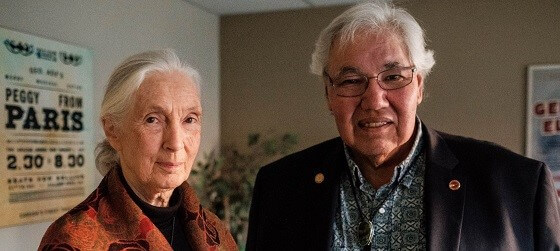Over the last seven years, the Canadian Parliament has been forging new ground in the protection of whales and dolphins and, most recently, other animals in captivity.

Senator Wilfred Moore
It’s interesting to note that the progress of this highly progressive legislation has been largely synchronous with the development of the Whale Sanctuary Project, the idea for which was first explored at around the same time as the launching of the first of these laws.
Legislative efforts began in December 2015, when Canadian Senator Wilfred Moore introduced the Ending the Captivity of Whales & Dolphins Act, listed as Senate Bill S-203. This ground-breaking work would take almost four years to come to fruition. It was overwhelmingly voted into law in June 2019.

Jane Goodall and Sen. Murray Sinclair
The following year, in November 2020, Senator Murray Sinclair partnered with Dr. Jane Goodall to introduce the Jane Goodall Act, which is now working its way through Parliament and, if passed, will become one of the strongest animal laws in history.

Senator Marty Klyne
In March of this year, 2022, Senator Marty Klyne reintroduced the Jane Goodall Act to the Canadian Senate as Bill S-241 and with new and even stronger provisions. During his speech, the senator noted:
“The coalition behind this bill has led efforts to establish new legal protections for over 800 species … In determining these priority species, based on welfare and safety concerns, zoo and NGO input has been valuable, along with the advice of Dr. Lori Marino. She is the animal neuroscientist who proved that dolphins are self-aware and who leads the whale sanctuary planned in Nova Scotia.”
Toward the end of his speech, Senator Klyne also spoke about the lone orca Kiska, who is held at Marineland Canada:
“Kiska was captured in Iceland in 1979 before being purchased by Marineland. Her five calves have died, and she has lived alone since 2011.
“… In her concrete tank, Kiska swims in repetitive, counter-clockwise circles and exhibits atypical behavior like floating motionless or thrashing her head at the poolside. Senators, this is not right. Kiska should not have to die alone, and if she can safely be moved, options need to be considered.
“For this reason, the Jane Goodall act’s preamble observes that the Ontario Government has jurisdiction to grant civil standing to Kiska. This would allow for a court order in her best interests by her own right, such as relocation to the whale sanctuary planned at Port Hilford, Nova Scotia.
On May 5th, as the bill proceeded through its Second Reading, Senator Peter Harder spoke as follows in the Senate:

Senator Peter Harder
“Bill S-241 … grants limited legal standing to animals in criminal sentencing for captive offences, notably illegal breeding or use in performance.
“… The practical effect of the bill could, for example, see the forced relocation — with costs — of all of a roadside zoo’s big cats if it were found that any of the zoo cats were to have been illegally bred. Similarly, if a proprietor were to stage an illegal whale show, the same could apply for the relocation of whales.
“This new version of the Jane Goodall act also encourages the Government of Ontario to grant civil standing to Kiska, the lone orca at Marineland, and basically advocates for recognition of her rights as an individual.”
And last week, on October 4th, Senator Jane Cordy rose to announce her support for the bill:

Senator Jane Cordy
“Honourable senators, Bill S-241 has the potential to establish the strongest legal protections for captive wild animals anywhere in the world … and it can also lead to change worldwide.
“After an extensive search, the Whale Sanctuary Project chose a bay in Port Hilford, Nova Scotia, to establish the world’s first whale sanctuary. This will be the first permanent seaside sanctuary in the world for beluga whales and orcas. The sanctuary will provide a natural environment for once-captive animals who are incapable of being released into the ocean for their own safety.
“… The sanctuary is gearing up to welcome their first inhabitants in 2023, and they have made it publicly known that their hope is to relocate Kiska the killer whale from Marineland as their first inhabitant.”
After further questions and debate of this Second Reading, the Senate will likely vote to send the bill to committee hearings, where expert witnesses will be called to testify and advise on the proposed legislation. Following these hearings, the committee will send the bill back to the full Senate for a Third Reading. And if the Senate votes to pass it, the bill will go to the House for a vote to enact it into law.
All of this takes time. As does establishing the whale sanctuary itself. And the history of each of these efforts continues to dovetail the other:
In August 2015, around the time that Senator Moore of Nova Scotia was conceiving his bill to end the captivity of whales and dolphins, a group of marine mammal scientists, veterinarians and trainers, engineers, non-profit groups and others met at the University of British Columbia. It was there that Dr. Lori Marino, who chaired the meeting, first raised the possibility of developing a coastal sanctuary for whales and dolphins who might be retired from entertainment facilities.
The history of each of these efforts continues to dovetail the other.The following year, in April 2016, as Bill S-203 – the Ending the Captivity of Whales & Dolphins Act – was proceeding through its first reading, the Whale Sanctuary Project was incorporated as a not-for-profit organization and began its extensive search, on both the east and west coasts of North America, for a suitable site.
In June 2019, as the Ending the Captivity of Whales & Dolphins Act was being voted into law, the site search was homing in on locations in Nova Scotia. And the following year, in 2020, soon after we announced our choice of Port Hilford Bay as the best location for the sanctuary, the Jane Goodall Act was introduced into Parliament.
Right now, as we continue the preparatory work that precedes construction of the sanctuary, the Jane Goodall Act is completing its Second Reading. And, if the Senate so votes, it will then head into committee hearings.
And meanwhile, at the end of July 2022, the new SWIMS Act (Strengthening Welfare in Marine Settings) was introduced into the United States Congress to prevent the future capture and breeding of whales for public display and thus, over time, to end the exploitation of whales in entertainment parks and aquariums.
It’s heartening to see the synchronicity in all of this work over recent years as public opinion grows toward retiring captive whales and dolphins to authentic sanctuaries.